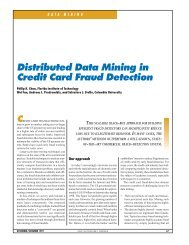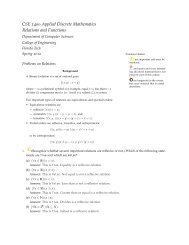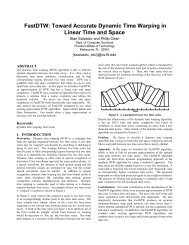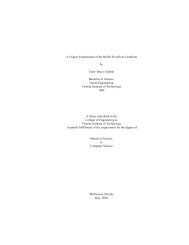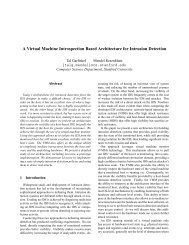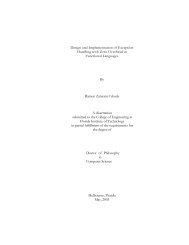Social Choice Theory and Recommender Systems ... - CiteSeerX
Social Choice Theory and Recommender Systems ... - CiteSeerX
Social Choice Theory and Recommender Systems ... - CiteSeerX
You also want an ePaper? Increase the reach of your titles
YUMPU automatically turns print PDFs into web optimized ePapers that Google loves.
average. The weighted average method is used in practicein many CF applications [Breese et al., 1998; Resnick etal., 1994; Shardan<strong>and</strong> <strong>and</strong> Maes, 1995]. One contributionof this paper is to provide a formal justification for it.Stated another way, we identify a set of properties, one ofwhich must be violated by any non-weighted-average CFmethod. On a broader level, this paper proposes a newconnection between theoretical results in <strong>Social</strong> <strong>Choice</strong>theory <strong>and</strong> in CF, providing a new perspective on the task.This angle of attack could lead to other fruitful linksbetween the two areas of study, including a category of CFalgorithms based on voting mechanisms. The next sectioncovers background on CF <strong>and</strong> <strong>Social</strong> <strong>Choice</strong> theory. Theremaining sections present, in turn, the threeaxiomatizations, <strong>and</strong> discuss the practical implications ofour analysis.BackgroundIn this section, we briefly survey previous research incollaborative filtering, describe our formal CF framework,<strong>and</strong> present relevant background material on utility theory<strong>and</strong> <strong>Social</strong> <strong>Choice</strong> theory.Collaborative Filtering ApproachesA variety of collaborative filters or recommender systemshave been designed <strong>and</strong> deployed. The Tapestry systemrelied on each user to identify like-minded users manually[Goldberg et al., 1992]. GroupLens [Resnick et al., 1994]<strong>and</strong> Ringo [Shardan<strong>and</strong> <strong>and</strong> Maes, 1995], developedindependently, were the first CF algorithms to automateprediction. Both are examples of a more general class wecall similarity-based approaches. We define this classloosely as including those methods that first compute amatrix of pairwise similarity measures between users (orbetween titles). A variety of similarity metrics are possible.Resnick et al. [1994] employ the Pearson correlationcoefficient for this purpose. Shardan<strong>and</strong> <strong>and</strong> Maes [1995]test a few measures, including correlation <strong>and</strong> meansquared difference. Breese et al. [1998] propose a metriccalled vector similarity, based on the vector cosinemeasure. All of the similarity-based algorithms citedpredict the active user’s rating as a weighted sum of theothers users’ ratings, where weights are similarity scores.Yet there is no a priori reason why the weighted averageshould be the aggregation function of choice. Below, weprovide two possible axiomatic justifications.Breese et al. [1998] identify a second general class ofCF algorithms called model-based algorithms. In thisapproach, an underlying model of user preferences (forexample, a Bayesian network model) is first constructed,from which predictions are inferred.Formal Description of TaskA CF algorithm recommends items or titles to the activeuser based on the ratings of other users. Let n be thenumber of users, T the set of all titles, <strong>and</strong> m=|T| the totalnumber of titles. Denote the n×m matrix of all users’ratings for all titles as R. More specifically, the rating ofuser i for title j is R ij, where each R ij∈ R∪{⊥} is either areal number or ⊥, the symbol for “no rating”. Let u ibe ann-dimensional row vector with a 1 in the ith position <strong>and</strong>zeros elsewhere. Thus u i⋅R is the m-dimensional (row)vector of all of user i’s ratings. 1 Similarly, define t jto be anm-dimensional column vector with a 1 in the jth position<strong>and</strong> zeros elsewhere. Then R⋅t jis the n dimensional(column) vector of all users’ ratings for title j. Note thatu i⋅R⋅t j= R ij. Distinguish one user a ∈ {1, 2, …, n} as theactive user. Define NR ⊂ T to be the subset of titles that theactive user has not rated, <strong>and</strong> thus for which we would liketo provide predictions. That is, title j is in the set NR if <strong>and</strong>only if R aj= ⊥. Then the subset of titles that the active userhas rated is T-NR.In general terms, a collaborative filter is a function f thattakes as input all ratings for all users, <strong>and</strong> replaces some orall of the “no rating” symbols with predicted ratings. Callthis new matrix P.Paj⎧R= ⎨⎩ faja: ifR( R): if Rajaj≠ ⊥= ⊥(1)For the remainder of this paper we drop the subscript onf for brevity; the dependence on the active user is implicit.Utility <strong>Theory</strong> <strong>and</strong> <strong>Social</strong> <strong>Choice</strong><strong>Theory</strong><strong>Social</strong> choice theorists are also interested in aggregationfunctions f similar to that in (1), though they are concernedwith combining preferences or utilities rather than ratings.Preferences refer to ordinal rankings of outcomes. Forexample, Alice’s preferences might hold that sunny days(sd) are better than cloudy days (cd), <strong>and</strong> cloudy days arebetter than rainy days (rd). Utilities, on the other h<strong>and</strong>, arenumeric expressions. Alice’s utilities v for the outcomessd, cd, <strong>and</strong> rd might be v sd= 10, v cd= 4, <strong>and</strong> v rd= 2,respectively. If Alice’s utilities are such that v sd> v cd, thenAlice prefers sd to cd. Axiomatizations by Savage [1954]<strong>and</strong> von Neumann <strong>and</strong> Morgenstern [1953] providepersuasive postulates which imply the existence of utilities,<strong>and</strong> show that maximizing expected utility is the optimalway to make choices. If two utility functions v <strong>and</strong> v′ arepositive linear transformations of one another, then theyare considered equivalent, since maximizing expectedutility would lead to the same choice in both cases.Now consider the problem of combining many peoples’preferences into a single expression of societal preference.Arrow proved the startling result that this aggregation taskis simply impossible, if the combined preferences are tosatisfy a few compelling <strong>and</strong> rather innocuous-lookingproperties [Arrow, 1963]. 2 This influential result forms the1 We define 0⋅⊥ = 0, <strong>and</strong> x⋅⊥ = ⊥ for any x ≠ 0.2 Arrow won the Nobel Prize in Economics in part for thisresult, which is ranked athttp://www.northnet.org/clemens/



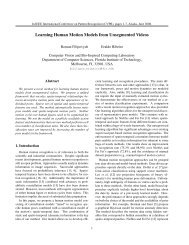
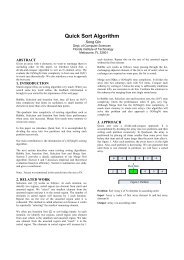
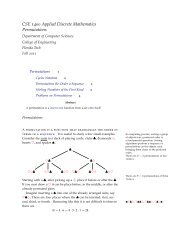
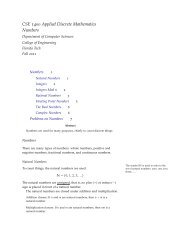
![{ public static void main (String[] args) { System.out.println (](https://img.yumpu.com/49719541/1/190x143/-public-static-void-main-string-args-systemoutprintln-hello-.jpg?quality=85)
